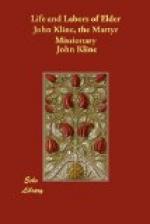SUNDAY, April 22. The two brethren had meeting at Doe Hill, in Highland County. They took dinner at Joel Siple’s, and had night meeting at George Wine’s. On the twenty-third they went down the South Fork to Jacob Stone’s and had meeting in one of his outbuildings. In the afternoon they had meeting at the widow Hoover’s on the Fork, and stayed all night at Dr. John Keister’s. On the twenty-fourth they had meeting at Bethel church in the forenoon; got dinner at Jacob Warnstaff’s, and in the afternoon have meeting at Zion church in Hardy County. They stayed all night at the widow Peggy Dasher’s. Mrs. Dasher (quoting from Diary) is a member of the Methodist denomination, and a very kind and hospitable woman. She lives up to her Christian profession as taught by her Discipline. We held family worship in her house and tried to impress upon the minds of her sons, who are intelligent and promising young men, the “one thing needful,” the giving of their hearts to the Lord.
WEDNESDAY, April 25. They had meeting at Nimrod Judy’s. Brother Kline spoke from Matthew 18:11. TEXT.—“The Son of man is come to save that which was lost.”
If man could fairly realize what he has lost through sin; and what may be gained by forsaking all for Christ; in other words, what it is to be lost, and what it is to be saved, he could not rest satisfied to remain one moment longer in his sin-ruined state. Like the Philippian jailer, he would instantly cry out, “What must I do to be saved?” Like the people on the day of Pentecost, being pierced as to their hearts by what they heard and saw, he would say: “Brethren, what shall I do?” “The Son of man is come to save that which was lost.” It is of the utmost importance to know what was lost, so as to know what it is that the Son of man came to save. I will try to tell you this. It is you, it is I, it is every human being upon the face of the earth. And are all lost? Yes, without an exception. To what extent are we all lost? To the extent of all that is of us—body, spirit and soul. And are our bodies lost? Yes, our bodies are lost to all that God intended them to be. Our bodies were never designed to be the abodes of disease and suffering; neither were they intended to be subject to infirmity from age. When God looked down upon a finished creation he saw that it was good, yea, very good. Can this be said of our bodies now? Let the blind, the deaf, the lame, the countless sufferers on beds of affliction, the child-bearing mother, the decrepit consumptive, the rheumatic invalid, let these say whether our bodies are very good now. And how about our spirits? I use the term spirit here in the sense of its being the basis of human perception and thought. Are our spirits or minds very good? Let those who are trying to learn and look into the secrets of knowledge and science answer this. From the child in school to the highest rank in scholarship ever held by any man, the same complaint comes up, that lessons are hard, and what is acquired as knowledge is very unsatisfactory.




